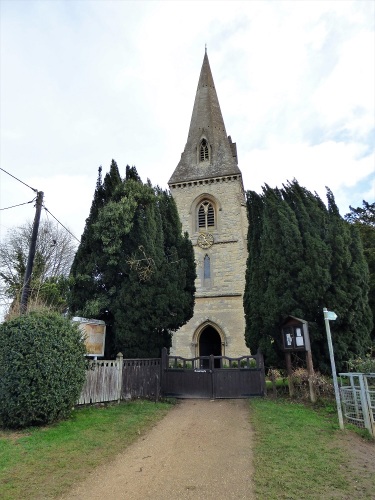
The door was actually open as we passed, so it would have been rude not to stop. “It could be a long morning…”said my son, settling back with amused resignation as I grabbed the camera and hopped out of the car in front of the second church in a couple of miles.
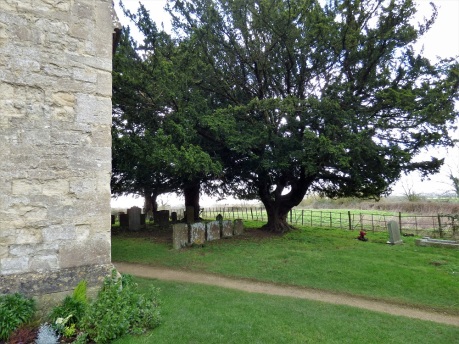
It was another of those churches where the doors have always been closed before, but even now that they invited me in, I did the obligatory walk around the exterior first, looking for those clues and details that tell so much about these old churches. This one, with yews shading the neat rows of gravestones, did not disappoint, for although there were no great architectural details to speak of its age, there were clues. There was a side door that seemed rather ‘Arts and Crafts’ and a series of old and interesting carved gravemarkers set into a more modern brick wall. Clearly, this church has seen many changes during its lifetime.
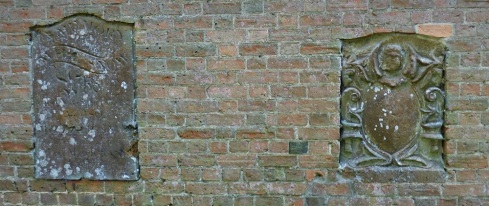
The church of St Michael stands in the village of Steeple Claydon. According to Wikipedia, the ‘steeple’ in the name does not refer to the towering structure perched upon the church, but to ‘Saint Eeple… the patron saint of bricklayers and heavy drinkers.’ A further entry on the village Facebook page, though, demands that whoever wrote that portion of the entry should own up…
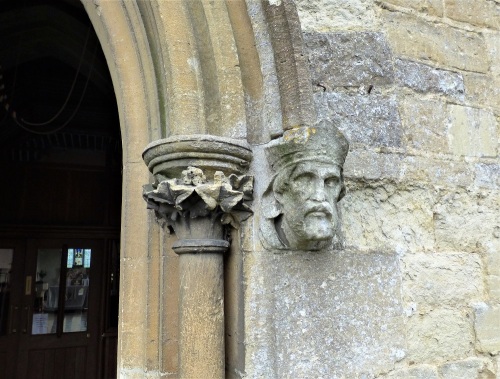
The manor once belonged to the Crown, but passed out of royal hands in the twelfth century, when King Henry I gave the lands to his mistress, Edith Forne, as her marriage portion. Edith, with whom Henry had two children, came of noble stock, being the daughter of Forn Sigulfson, Lord of Greystoke, so, when the time came for the king and his mistress to part, in 1120, he caused her to wed Robert D’Oyly. The manor passed to Robert upon his marriage and Edith sought expiation for her sins following a dream of chattering magpies, by founding the now-defunct Osney Abbey, near Oxford.
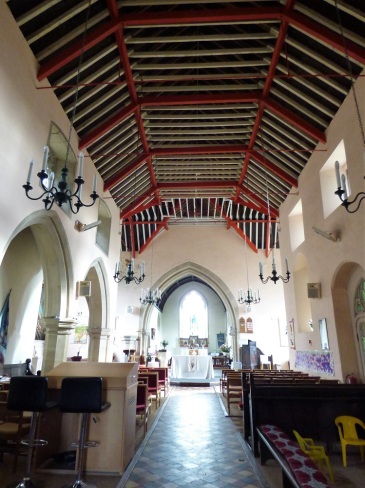
The church that stands in the village goes back no further than 1380, though, with the chancel being the oldest part of the present building. The nave was widened a century later with other alterations and additions being far more modern. Perhaps the most startling thing you see on first entering is the painted, beamed roof. The red paint seems to make it far more colourful than it actually is.
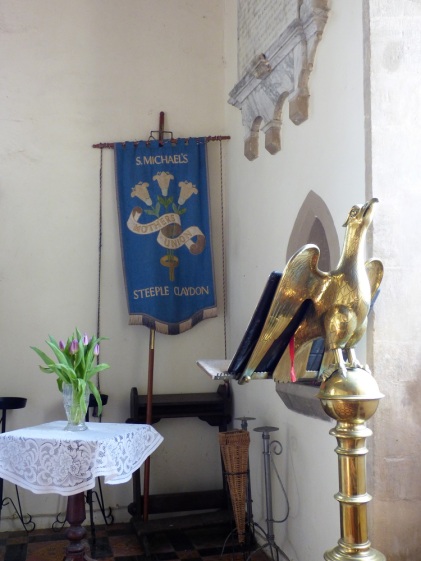
The church was restored in 1842 by Sir George Gilbert Scott and again in 1875 with his son, John Oldrid Scott. In contrast to the little church a few miles down the road at Middle Claydon, this one doesn’t seem to have kept that indefinable air of tranquility and sanctity in quite the same way.
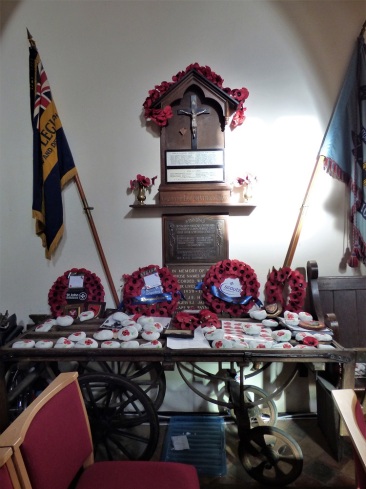
On the other hand, it is plainly a much-loved and well used part of the community, with children’s areas, and displays of childish arts and crafts sitting side by side with memories of older times. The Roll of Honour, surrounded by poppies and painted and inscribed pebbles, sits above the wheeled bier used to bring the coffins of the dead to the altar. The banner of the Mother’s Union sits against the wall, and the octagonal font that has baptised parishioners for the past six hundred years still waits to serve the villagers beneath its seventeenth century cover.
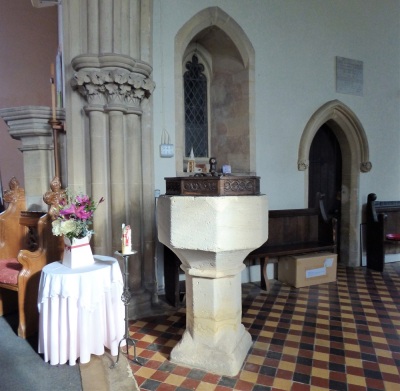
The painted organ seems rather homely… and that is the overriding feeling in this place. Slightly shabby, well-loved and lived-in. Yet, it has had ts share of ups and downs…
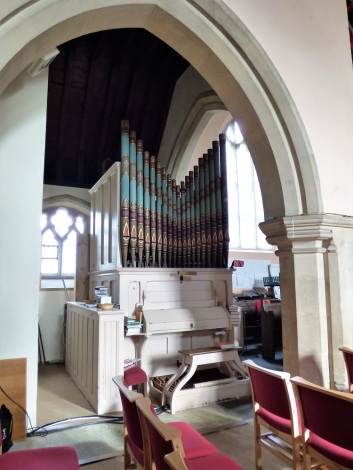
The manor changed hands many times over the centuries, eventually returning to the Crown at the time of Edward IV. They remained royal lands until they were granted to the statesman, soldier and poet, Sir Thomas Chaloner, in 1557, but they did not remain long with that family. In 1649, two of Chaloner’s grandsons, Thomas and James, took part in the trial of King Charles I.
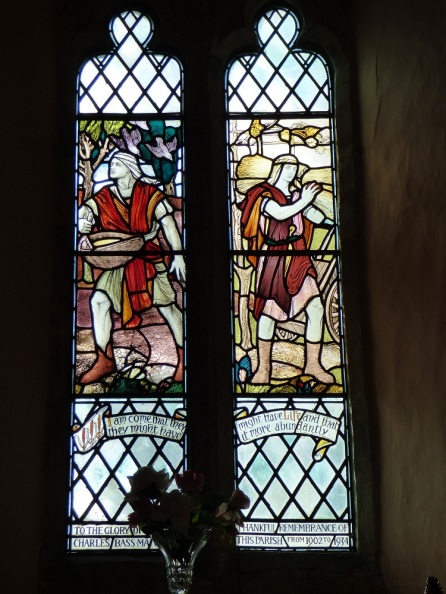
Thomas was one of the signatories of the warrant of execution that led to the beheading of the king. When the king’s son reclaimed his throne as Charles II, almost all of those who had been involved in the troubles of the interregnum were given a general pardon.
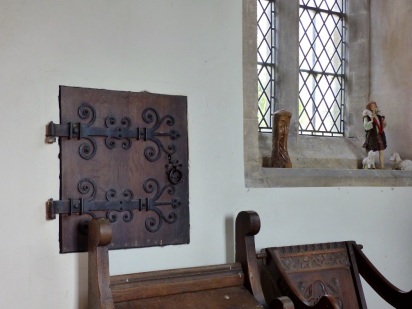
Only those who had committed serious crimes were excluded from the pardon.. and the regicides. James had not signed the warrant and was spared. Thomas fled the country to escape execution and died abroad.
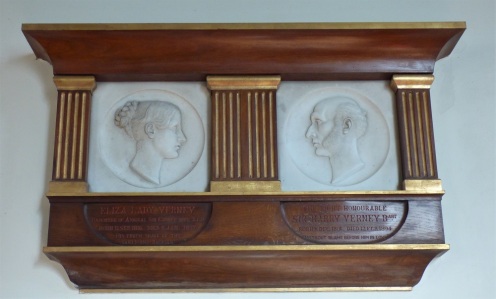
His lands were forfeit for his crime, but the family bought them back, eventually selling them to the Verney family in 1705. The Verney family had lived at Claydon House since 1620… and, although the house was rebuilt as a beautiful stately home, they still live there today. A memorial to Sir Harry and Lady Eliza Verney, dated 1839, watches over the church.
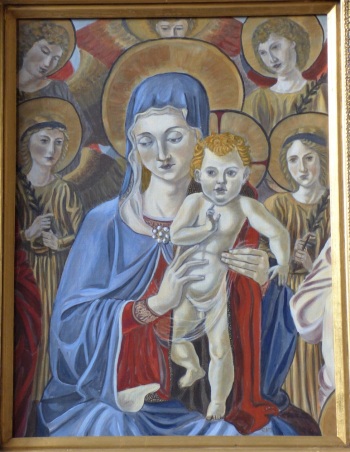
They are not the only watchers, though. There are many eyes, from the painted artwork on the walls to those of the stained glass windows.
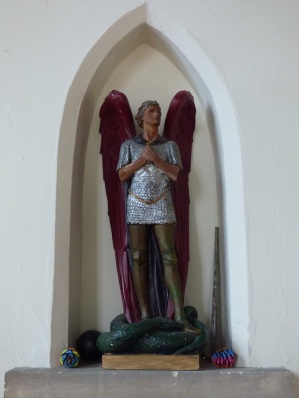
From the traditional…and less traditional…. statuary, there is a distinct feeling of benevolent surveillance in this church. Even though you have the place to yourself, you do not feel entirely alone…
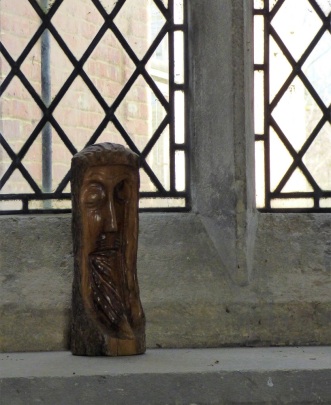
I don’t know quite what it is… It is almost as if the quiet, hardworking life of the village that permeates these old walls, in such contrast to the drama of politics and high society, has shouldered the burden of events and learned both acceptance and compassion.
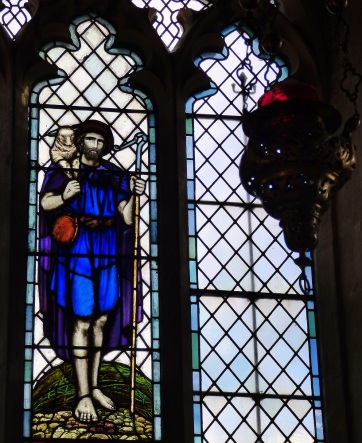
Even the dragon slaying St George in the window allows his dragon to rest in peace, with its eyes open. It cradles the lance in the crook of its arm, rather than being pinned down or pierced by the point of the weapon. St Michael looks on serenely.
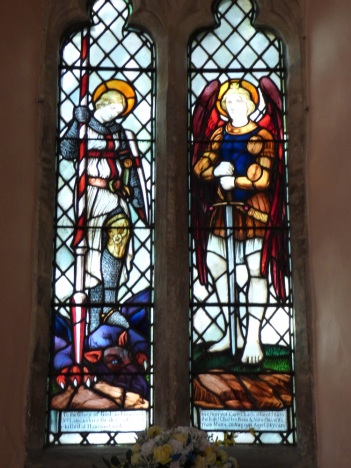
There is nothing special about this church… it is typical of so many rural churches that we visit across the land… and yet, the sense of community that seems so strong here is what is lacking in our towns and cities… and in the global community of which we are a tiny part. Perhaps living closer to the land, with its reliance on the natural rhythms and its cycle of poverty and plenty keeps its folk connected.
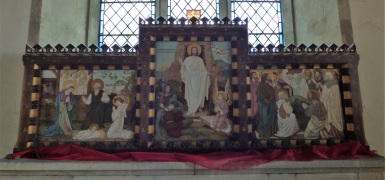
That same cycle is played out symbolically in the beautifully painted reredos. The three scenes show the birth of Jesus, the Resurrection and the Ascension.
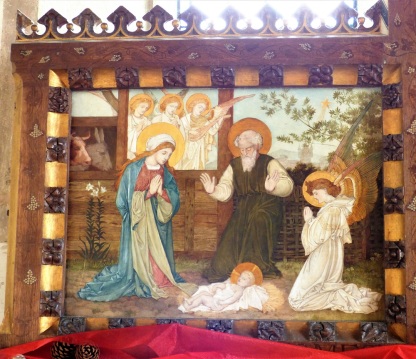
It doesn’t take a great deal of imagination to see how these scenes from the story of the Christ relate to the process of a more earthly life-cycle, or to the evolution of consciousness that grows in compassion as it awakens.
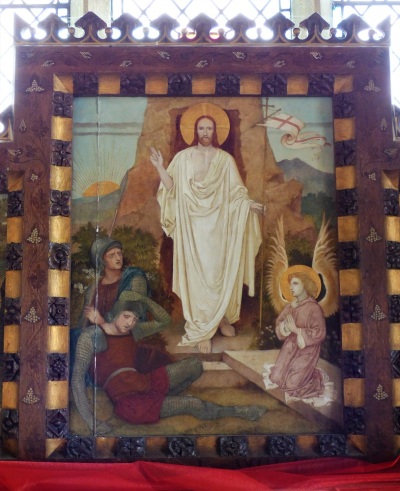
That is one of the beauties of visiting these old places… so deeply ensconced in the heart of their community that their antiquity and their treasures are often overlooked through sheer familiarity. You do not have to be part of their congregation, or even of their religion, to enjoy their peace and their beauty. Nor to learn from the symbols and stories painted and carved upon their walls and windows… for symbols need not belong to any one story; they speak straight to the heart if we let them.
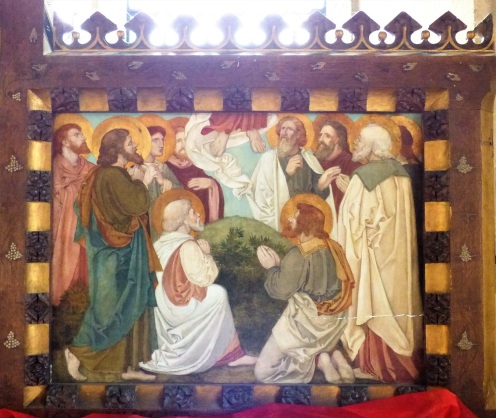









































Another beautiful church, Sue. I like the intermingling of the old with the new and the sense of continuity.
LikeLike
That is part of the charm of these old churches.
LikeLike
Another gem. In truth, all parish churches pretty much are. Grab their histories and you could join them all up! Very unusual roof; love the little figure of St Michael…
LikeLike
I rather liked the fact that the saint stood swordless… with the blade leaning beside him, discarded.
LikeLike
What a lovely church. The white, deep red and royal blue of the religious objects and paintings, the gracious but unpretentious arches and the earthy colours of the stained glass windows all combine to give a sense of a living faith.
LikeLiked by 1 person
It is very much a living church, this one… though I found that life mostevident in the ‘messy church’ area for the children. 🙂
LikeLiked by 1 person
Yes, it does look like a very vital place. Not many conventional churches do these days – at least over here in Australia.
LikeLike
To be fair, most of the village churches here are still very much alive.
LikeLiked by 1 person
Really. Over here most churches in country towns look like they are dying. But then many country towns are dying over here what with droughts, young people leaving for the cities and lack of services like doctors. It would make a good photo study.
LikeLike
The same problems affect out villages, but the churches are a hub for village life.
LikeLiked by 1 person
I can see this church being a bit more country. One of the things I thought was weird was how Mary was pulling what I think was an invisible cloth over the Baby Jesus’s peepee. What a bizarre artistic choice to show a desire for propriety then draw through it anyway!
LikeLiked by 1 person
Perhaps the symbolism goes a bit deeper. I’d love to know what was in the artist’s mind. Perhaps showing the humaninty of deity incarnate?
LikeLiked by 1 person
Hmm… maybe. I hadn’t thought of it that way.
LikeLike
There is usually something in these details.
LikeLiked by 1 person
Another inspiring church post, Sue. An excellent account of a church and it’s links with historical people and events. I do know this one, but not all that well, so you’ve shown me a lot. And you’re so right, these ancient sites and buildings are too often overlooked, even though they offer such tantalising ties to the past just because they’re familiar fixtures in the neighbourhood. Your timing is eerie, as I’m just about to do the same thing. I’m doing a 10-mile walk tomorrow, taking in my local town of Buckingham and all it’s medieval history which many locals probably aren’t even aware of. It’s all there to be discovered, just outside our own front doors. Thanks for sharing.
LikeLike
There is an awful lot in and around Buckingham, so I look forward to reading about it, Alli. I keep meaning to run out and visit St Rumwald’s Well there and the Chantry chapel.
LikeLike
Funnily enough, both of those are on the agenda! Should be good. It’s nice to have a kindred spirit blogger!
LikeLike
And on each other’s doorsteps too, just about, so knowing many of the same places. 🙂
LikeLiked by 1 person
That’s right – it gives it a more personal feel. I’m pleased to have a blogging ‘neighbour’! 🙂
LikeLike
Me too 🙂
LikeLiked by 1 person
Such delicious history available to you on your forays into the country… Jealous…
LikeLike
We are exceptionally luckt to have somuch still on our doorstep 🙂
LikeLike
Your poor son. But the door was open, and you would have been rude…. lol. Nice photos and history, as usual.
LikeLike
He’s getting used to it…and doesn’t object to enjoying the sunshine in a green village. 🙂
LikeLiked by 1 person
It’s amazing, Sue, how many of the churches you visit are intertwined with the history of the region and country. The church is beautiful. 🙂 I do love that this place is still loved and used by the community.
LikeLike
It is easy to forget in this day and age, but the church was at the centre of every community, and life and politics, as well as faith, revolved around the church for around fifteen hundred years. So many of the older churches we are still lucky enough to have, were hubs for the life and people of the country.
LikeLiked by 1 person
Really enjoyed this tour–those painted beams are fascinating.
LikeLike
It isn’t the first time we’ve seen painted beams, but these really stand out.
LikeLike
Yes, they do 🙂
LikeLiked by 1 person
Your son is very much like my husband, we are very lucky that they know we can not resist an open door, or even a closed one. Another lovely interesting church, I think I have come to terms with the fact I am not going to visit every church in the land ha ha, so I can enjoy visiting with you the churches in your county and try to visit as many as I can in my own county, plus ones in passing 🙂
LikeLike
That’s the beauty of there being so many churchaholics with blogs 😉
LikeLiked by 1 person
And long may it be so 🙂
LikeLike
Amen to that 🙂
LikeLiked by 1 person
🙂 🙂
LikeLiked by 1 person
The painted reredos are quite lovely for a small country church, and what a chequered history!
LikeLike
Most of these little churches have treasures to discover…and all of them seem so connected with history that they all have stories to tell.
LikeLiked by 1 person
The few, oldest buildings here are barely 400 years old, so not a lot of history to them. The UK, on the other hand, is rich in history!
LikeLike
And most of us wander past it every day without taking any notice…
LikeLiked by 1 person
I so enjoy these posts, Sue! Thank you for sharing the lovely little places that I cannot visit any other way.
LikeLike
I love being able to share them.
LikeLiked by 1 person
The patron saint of bricklayers and heave drinkers? Another beauty of a church. I love the tiny door in the wall with the ornate iron hinges.
LikeLike
I know… I loved the comment on their FB page.. ‘Come on, own up…’
The little doors in the wall are usually called the aumbry and these are used for storing the Chalice and Paten. By rights, though, a true aumbry should be veiled.
LikeLiked by 1 person
Thank you, Sue.
LikeLiked by 1 person